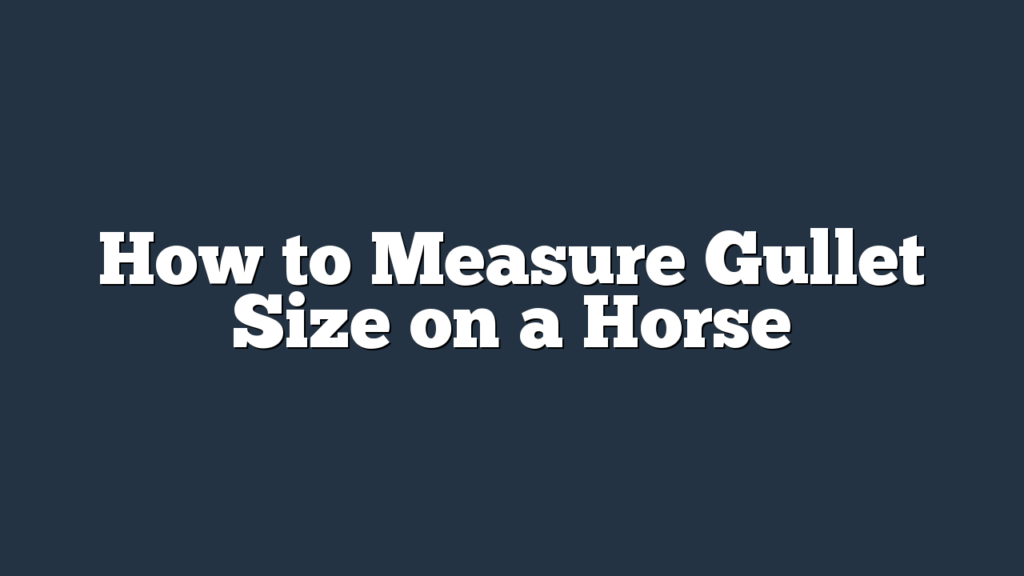Are you unsure about how to measure your horse’s gullet size? Don’t worry, we’ve got you covered!
In this article, we will guide you through the step-by-step process of measuring your horse’s gullet size. By understanding the importance of gullet size and selecting the right tools for measurement, you’ll be able to ensure a comfortable fit for your horse’s saddle.
So let’s dive in and learn how to measure the gullet size on your horse!
Understanding the Importance of Gullet Size
To properly fit a saddle on your horse, it’s essential to understand the significance of the correct gullet size. Many riders make common gullet size mistakes, which can have a significant impact on their horse’s performance.
One of the most common mistakes is using a saddle with a gullet size that’s too narrow. When the gullet is too narrow, it puts excessive pressure on the horse’s withers, causing discomfort and potentially leading to soreness or even injury. This can result in a decrease in performance, as the horse may become resistant or unwilling to move freely.
Conversely, using a saddle with a gullet size that’s too wide can also cause problems. A wide gullet can create instability and poor weight distribution, leading to an unbalanced and uncomfortable ride for both horse and rider. The horse may struggle to maintain proper collection and engagement, affecting their overall performance and ability to perform specific movements or tasks.
Therefore, it’s crucial to find the correct gullet size for your horse. Properly fitting a saddle with the right gullet size ensures that your horse can move comfortably and perform at their best.
Selecting the Right Tools for Measurement
When measuring gullet size on a horse, it’s important to have the right tools for accurate and precise measurements. There are different types of gullet size measuring tools available, each with its own advantages and disadvantages.
The first type is a gullet gauge, which is a metal or plastic device that’s placed over the withers and allows you to measure the width of the gullet. This tool is commonly used by professionals and is known for its accuracy.
Another option is a flexible measuring tape, which can be wrapped around the gullet to determine its size. This tool is easy to use and more affordable, but may not provide the same level of precision as a gullet gauge.
When choosing a gullet size measuring tool, there are several factors to consider. Firstly, consider the accuracy and reliability of the tool. You want a tool that will provide consistent measurements every time.
Additionally, consider the ease of use and convenience. Some tools may be more user-friendly and easier to handle than others.
Finally, consider your budget. Determine how much you’re willing to spend on a gullet size measuring tool and choose one that fits within your price range.
Preparing the Horse for Gullet Size Measurement
Now, take the horse’s comfort into consideration as you prepare them for gullet size measurement. Before you begin, it’s important to ensure that the horse’s back is clean and free from any debris or dirt. Gently brush the area to remove any loose hair or dirt that could interfere with the accuracy of the measurements.
Next, make sure the horse is standing on level ground, as this will help you get precise and consistent measurements.
To prepare the horse’s back, place a clean and well-fitting saddle pad on their back. This will provide a comfortable and stable surface for the measurement. Adjust the pad so that it sits evenly and doesn’t create any pressure points or gaps. It’s crucial to have the horse’s back in a neutral position, meaning no arching or hollowing. This will ensure the most accurate measurement of the gullet size.
Additionally, it’s important to have someone assist you during the measurement process. They can help hold the horse steady and ensure that the saddle pad remains in place. This will help you get the most accurate measurements possible.
Measuring the Gullet Size Step-by-Step
Start by placing a flexible measuring tape horizontally across the horse’s withers. This will serve as the starting point for measuring the gullet size on a horse. Once the measuring tape is in place, follow these steps to measure the gullet size accurately:
- Ensure that the horse is standing square and relaxed to get an accurate measurement.
- Hold the measuring tape firmly but not too tightly to prevent any discomfort for the horse.
- Measure the distance between the highest point of the withers and the underside of the gullet. This will give you the gullet size measurement.
- Repeat the measurement a few times to ensure accuracy and take note of the average measurement.
It’s important to note that gullet size variations can occur between different horse breeds and individual horses. Each horse is unique, so it’s essential to measure the gullet size for a proper fit of the saddle.
Additionally, there are common misconceptions about gullet size, such as assuming that a wider gullet is always better. However, the correct gullet size is determined by the horse’s conformation and the shape of its withers. It’s crucial to measure accurately and consult with a professional saddle fitter if needed to ensure the best fit for your horse.
Interpreting the Results and Making Adjustments
To interpret the results and make any necessary adjustments, you will need to consider the horse’s comfort and the saddle fit. Adjusting the saddle fit based on gullet size measurements is crucial in ensuring that the horse is comfortable and able to move freely. An incorrect gullet size can lead to various issues, such as pinching, rubbing, or even pressure sores. By addressing these issues promptly, you can prevent discomfort and potential long-term damage to your horse.
Here is a table that summarizes common issues caused by an incorrect gullet size and how to address them:
| Issue | Symptoms | Solution |
|---|---|---|
| Pinching | Horse shows signs of discomfort, such as flinching or bucking | Use a wider gullet size or adjust the saddle padding to alleviate pressure points |
| Rubbing | Hair loss or sores on the withers or back | Opt for a narrower gullet size or consider using a different type of saddle pad to reduce friction |
| Pressure Sores | Open wounds or swelling in the girth or back area | Consult a professional saddle fitter to assess the saddle fit and make necessary adjustments |
Frequently Asked Questions
What Are the Common Signs That Indicate a Horse’s Gullet Size Needs Adjusting?
If your horse’s gullet size needs adjusting, there are common signs to look out for. These signs include discomfort while eating, difficulty swallowing, and resistance to the bit. It’s important to measure and adjust the gullet size accordingly.
Can Gullet Size Affect a Horse’s Overall Performance and Comfort While Riding?
Proper gullet size is crucial for your horse’s well-being and overall performance. It affects saddle fit and ensures comfort while riding. Ensure you measure gullet size accurately to provide the best experience for your horse.
How Often Should Gullet Size Be Checked and Adjusted?
To ensure your horse’s comfort and performance, it’s important to regularly check and adjust the gullet size. You should determine the checking frequency and adjusting necessity based on your horse’s individual needs and any changes in their body condition.
Are There Any Specific Breeds or Types of Horses That Require Special Consideration When Measuring Gullet Size?
For special considerations regarding gullet size, it’s important to note that draft horses may require wider gullets to accommodate their larger size, while gaited horses may benefit from narrower gullets to enhance their movement.
Is There a Recommended Gullet Size Range for Different Disciplines, Such as Dressage or Jumping?
For different disciplines like dressage or jumping, there is a recommended gullet size range. It’s also important to consider the correlation between gullet size and bit selection, especially when barrel racing.
Conclusion
In conclusion, accurately measuring the gullet size of a horse is crucial for ensuring the proper fit of a saddle.
By understanding the importance of gullet size, selecting the right tools, and following the step-by-step process, horse owners can make necessary adjustments to ensure the comfort and well-being of their equine companion.
Taking the time to measure and interpret the gullet size will ultimately lead to a better riding experience for both horse and rider.



